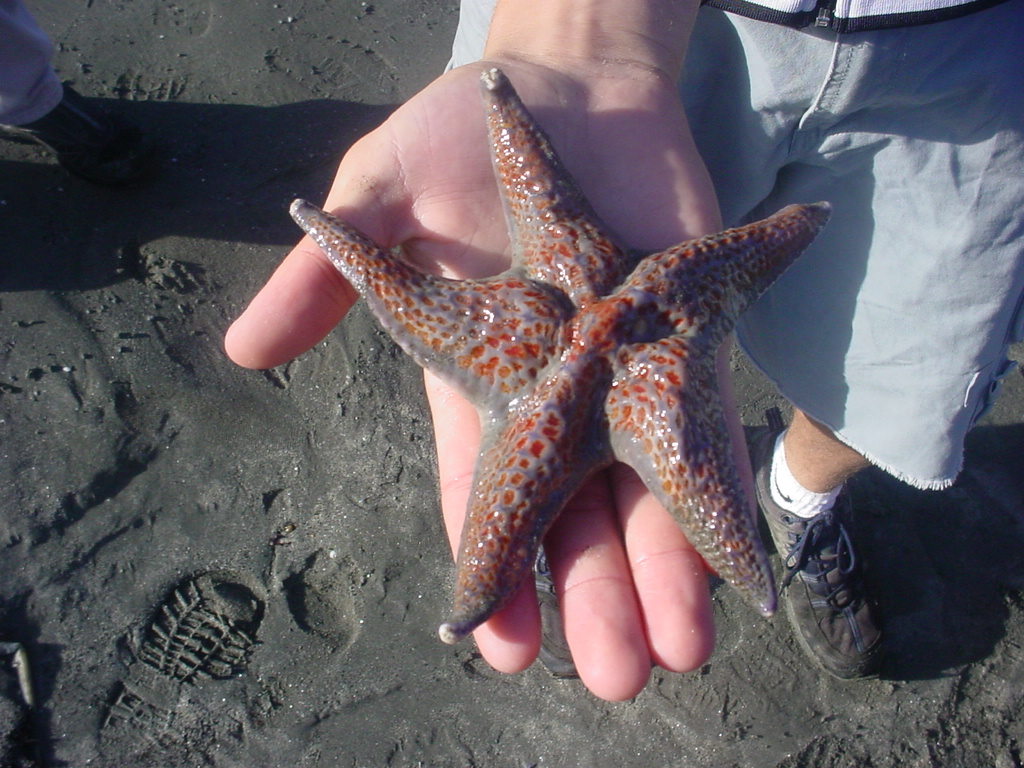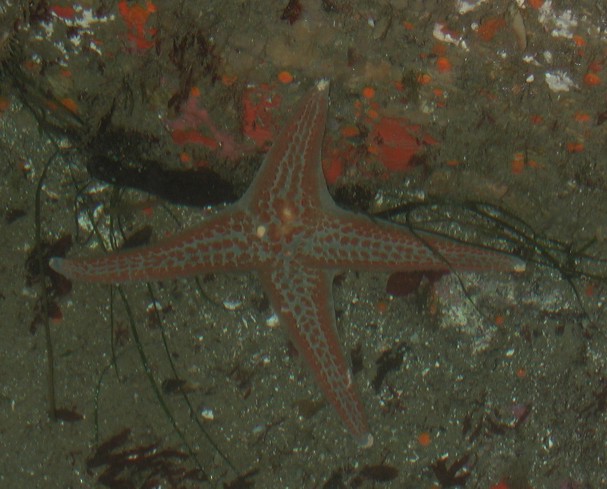Dermasterias imbricata (Grube, 1857)Common name(s): Leather star |
|
| Synonyms: |  |
| Phylum Echinodermata
Class Asteroidea Order Valvatida Suborder Granulosina Family Asteropseidae |
|
| Dermasterias imbricata at Beach #4, WA | |
| (Photo by: Dave Cowles, July 2005) | |
How to Distinguish from Similar Species: Pteraster tesselatus does not have a visible madreporite and secretes copious quantities of slime. Asterina miniata and Mediaster aequalis have clearly visible interlocking ossicles on the aboral surface.
Geographical Range: Sitka, Alaska to Sacramento Reef, Baja California, Mexico; more common in the northern half of its range
Depth Range: Intertidal to 90 m
Habitat: Mostly on rocks, can also be found on sand or mud. Seems to prefer at least partially sheltered areas.
Biology/Natural History: Prey include diatoms, sponges, bryozoans, sea pens, anemones, sea cucumbers, sea urchins, and chitons, ascidians, and fish eggs. Anemones are said to be one of its major prey items. It usually swallows its prey whole and digests them internally. The swimming anemone Stomphia sp has a strong escape response from this species (see movie); as does the purple urchin Strongylocentrotus purpuratus. Stomphia swims away, while S. purpuratus pulls in its tube feet, depresses its spines, and extends its pedicellariae; then races away. The scaleworm Arctonoe vittata is a common commensal, and the worm and the seastar are mutually attracted to one another. A parasitic barnacle Dendrogaster sp may be found inside. In Wasington, spawning is from April to August. Females release yellow eggs which are fertilized in the water.
| Return to: | |||
| Main Page | Alphabetic Index | Systematic Index | Glossary |
References:
Dichotomous Keys:Flora and Fairbanks, 1966
Kozloff 1987, 1996
Smith and Carlton, 1975
General References:
Brusca
and Brusca, 1978
Carefoot,
1977
Gotshall,
1994
Harbo,
1999
Hinton,
1987
Johnson
and Snook, 1955
Kozloff,
1993
McConnaughey
and McConnaughey, 1985
Morris
et al., 1980
Niesen,
1994
Niesen,
1997
O'Clair
and O'Clair, 1998
Ricketts
et al., 1985
Sept,
1999
Scientific
Articles:
Knott, K. Emily, and Gregory A. Wray, 2000. Controversy and consensus
in Asteroid systematics: new insights to Ordinal and Familial
relationships. American Zoologist 40:3 pp. 382-392
Web sites:
General Notes and Observations: Locations, abundances, unusual behaviors:

This individual, seen in a tidepool at Cape Flattery, has only 4 rays.

This individual, also at Cape Flattery, is regenerating one or two rays, giving it six rays! Photo by Dave Cowles, July 2019
Authors and Editors of Page:
Dave Cowles (2005): Created original page